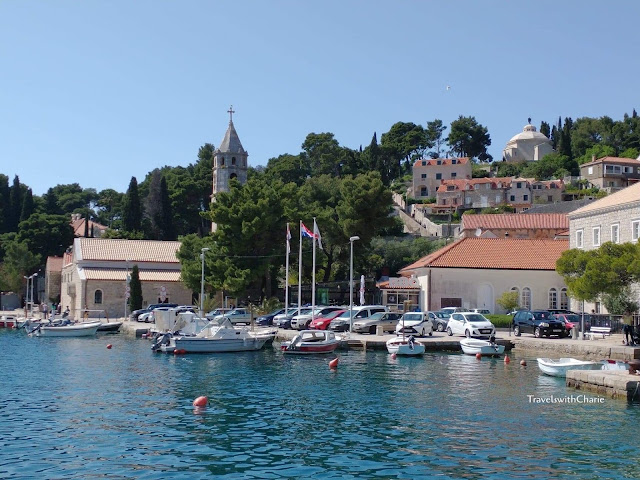Cavtat and Luka Bay
Many moons ago, I was lucky to have spent a week in Dubrovnik in the off season. It was enchanting and tranquil then. I had a room at the Hilton Imperial with a view of St. Lawrence Fortress (Lovrijenac). The fortress glowed at night and it was magical! But Dubrovnik has changed quite a bit in the intervening years. Current hotel rates there are beyond my budget and the city is crowded with visitors who want to see one of the locations of Game of Thrones. So this time around, I chose to stay in Cavtat (pronounced tsav-tat). It is a small, relaxed village on the Rat peninsula just thirty minutes south of Dubrovnik. It turned out to be a great choice!Franciscan Monastery and Church of Our Lady of the Snow with
Supetar Island in the distance
Račić Family mausoleum (on the hilltop) and marina
Vlaho Bukovac
Vlaho Bukovac (Biagio Faggioni) is one of the foremost Croatian painters and is considered an early exponent of modern Croatian art. He was born in Cavtat where he spent his early years. He moved to New York to be with his uncle when he was 11 years old and stayed there for four years. He took a a job as a sailor upon his return to his hometown. He later studied at the Ecole des Beaux Arts in Paris under the tutelage of Alexandre Cabanel. He lived in various cities including San Francisco, California and Zagreb before settling down in Prague where he was appointed assistant professor at the Academy of Fine Arts. He stayed in Prague until his death in 1922. Bonhams sold his painting Une fleur (Reclining Nude) for £100,800 at an auction in London in 2006. See image here: https://www.bonhams.com/auctions/14216/lot/33/. You can see a few of his paintings at his home in Cavtat which is now a museum.
 |
| Bust of Dr. Franjo Tudman |
Dr. Franjo Tudman was the first president of Croatia after it gained its independence from Yugoslavia in 1990.
Church of St. Nicholas
This is a 15th century Catholic Church, rebuilt and restored several times. The steeple is from the 1830s. There are paintings of the four evangelists by Vlaho Bukovac in the Church.View of Tiha Bay from Setnica Rata Trail on the Rat Peninsula
One of the things I like best about Cavtat are the walking trails and the views of blue sea and sky. You can walk along the seaside promenade to the Mausoleum or enjoy the peace and quiet of Setnica Rata park and trail. There’s also a hiking trail on the Sustjepan peninsula. There are more trails to discover in and around Cavtat.
View of neighboring beaches and resorts on Tiha Bay
No need to worry where to get cash. There are ATM machines everywhere including at the seaside promenade.
Just before sunset is the best time to take a walk on the waterfront. Some of the most beautiful sunsets I’ve witnessed have been in Croatia.
Caught the sun setting from my bedroom window.
How to get there:
Cavtat is 10 minutes from Dubrovnik International airport. I took Uber to my hotel and it was considerably cheaper than taking a taxi. There’s a ferry that goes to Dubrovnik several times daily from Cavtat. There’s also a small bus terminal by the harbor for trips to nearby towns and Dubrovnik.
Where to stay:
Boutique Hotel Villa Pattiera
Trumbićev put 9, Cavtat
I can’t say enough good things about this boutique hotel. My room was spacious and spotless, the ladies at the reception desk took good care of me, helped me find a tour to Medjugorje and worried about me when I didn’t show up for breakfast on my first morning there. (I had an early morning tour to Montenegro.) The hotel is located across the seaside promenade and is a stone’s throw from restaurants, grocery stores, banks, bus terminal and harbor. And most importantly, the room rate was reasonable. I hope I can stay there again in the near future.
Terrace at Villa Pattiera
Where to eat:Restaurant Dalmacija
Trumbićhev put 9
Since Cavtat is by the sea, you’ll have a wide selection of seafood on the menu. The fish dishes I tried were fresh, succulent and served with vegetables and bread. The risotto was very good and I wanted to order it again the next day. As you can see, I ate well during my stay.
*****
Images by TravelswithCharie













